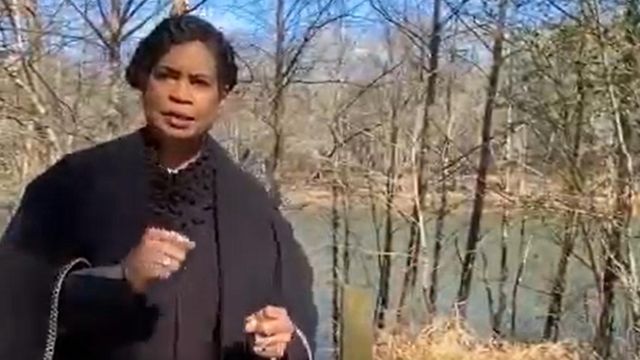Secret passageways and freedom roads: Remnants of the Underground Railroad in NC

When visiting North Carolina’s idyllic little coastal communities, visitors may not expect that some of those quaint riverside buildings once held secret passageways and smuggling tunnels.
Enslaved men and women escaping from large plantations in Raleigh or farther west would often float down rivers and tributaries – bodies of water known as "Freedom Roads" that eventually led to coastal towns, where they could catch a ship up north to freedom.

While waiting for a ship, they often hid out in swamps, wooded areas or, if they were lucky, a secret passageway in an abolitionist’s home.
Waiting at the end of the Pamlico River – one of North Carolina’s most prominent freedom roads – was the coastal community of Washington. With shipyards like Havens Wharf and old plantations like Elmwood, the small city was at the heart of the Underground Railroad.
While most stories from the Underground Railroad have vanished with the ages, some tangible remnants and clues can still be found in the area surrounding modern-day Washington.

Abolitionists sneak onto Elmwood Plantation
With 89 enslaved individuals over 280 acres, Elmwood Plantation was the largest plantation in the county in the 1800s. Some of the men enslaved there were sent to Havens Wharf to work in the shipyard.
It was this exact setup that made Washington an ideal headquarters for the Underground Railroad.
Like spies, abolitionists would infiltrate plantations like Elmwood, allowing them to find enslaved individuals who were seeking freedom.

“Abolitionists would go to work on plantations,” explained Leesa Jones, director of the Washington Waterfront Underground Railroad Museum. “Many times, they would develop skills that were greatly needed on plantations, such as blacksmithing or creating metal farm tools. If you had a skill you could teach to enslaved individuals on a plantation, it would be profitable for a plantation owner to hire you to work with their enslaved population.”
“Preachers were always welcome. Midwives were always welcome. Tanners were always welcome,” she said.
Once on a plantation, abolitionists would get a sense of which enslaved men or women might be seeking freedom.
“You always had someone, called an Ear, who was working to pick up information on who can be trusted,” said Jones.
Elmwood and Havens Wharf provided an ideal atmosphere for bringing in information from abolitionists up north. Bustling shipyards brought in northern traders, who sympathized with the abolitionist cause. Enslaved individuals worked directly in the shipyard and could glean information about how to escape, then bring it back to Elmwood.

Due to the immense danger involved in helping people escape enslavement at plantations, these codes often lasted only a few days before being changed. This constant need for secrecy and clandestine codes is part of why the history of the Underground Railroad is difficult to uncover. Written history would be too risky, and even oral history would have been dangerous to pass down.
“We always tell people to pay attention to the stories they hear told by older family members – there’s a genesis in them. Investigate them. A lot of Underground Railroad history is oral,” said Jones.

Codes and secret communications in the Underground Railroad
Secret codes could be found in nearly anything – clothing, crops, songs and rhymes – and conveyed messages about which routes to take, when it was safe to run, how to stay safe and other important information.
“The code would utilize something the freedom seeker already had on hand,” said Jones. “Nothing about a code could seem out of place.
“For example,” said Jones, “Oral history tells us about the use of sunflowers on the waterfront. People sold sunflowers on the waterfront regularly. So, if someone were out there, that doesn’t look unusual.”
According to Jones, abolitionists might stand on the waterfront of the Pamlico River holding a basket of sunflowers, but the tip off that they were passing a code was this: They never announced their flowers were for sale.
“If they were not announcing they were selling the sunflowers, I’d know they were there to help and had a code for me,” said Jones.
The center of a sunflower might be used to symbolize eyes, and the flowers could be tilted to silently indicate from which direction ‘eyes’ might be lurking – or where dangerous patrols might be looking for escapees.
People might spend days – or longer – waiting in hiding until they could safely board a boat. Meanwhile, secret messages could be passed along.
Freed Black men or abolitionists might scatter black-eyed peas along the waterfront to let someone hiding in the forest know "too many eyes are watching. Stay hidden."

People seeking freedom could also use codes to seek help from abolitionists.
“For example, if you saw an enslaved woman wearing a long dress with three petticoats, she may swish her skirts to reveal a thread color while singing a song,” said Jones. “The color thread would signal to an abolitionist what kind of help she needed.”
Blue thread might mean, “Help, I need help by way of the river.”
Green thread could mean, “I need help on an overland route.”
Gold thread could mean, “Please, I need help by way of stagecoach.”
Washington had a stagecoach line that could take people to Plymouth or New Bern.
In the hustle of busy merchants announcing their wares, docking ships, enslaved men unloading shipments, a few spilled black-eyed peas might go unnoticed by anyone except someone silently watching and waiting for the right time to escape.

Modern songs and nursery rhymes that harken back to the Underground Railroad
People today might be surprised to realize they recognize some of the old Underground Railroad codes and songs that were passed along through generations, disguised as nursery rhymes and folk music.
In the early 1960s, Bob Dylan wrote “Blowin’ in the Wind,” a song that referenced racial injustice, asking how many roads a man must walk down before he can be called a man. The lyrics also referenced peace, asking how many seas a white dove must sail before she sleeps in the sand.
And, most of all, the song said “The answer, my friend, is blowin’ in the wind. The answer is blowin’ in the wind.”
Jones said, “The lyrics are based on an old slave code that would have been used by the Underground Railroad. But there’s an appendage to that song that did not make it into the popular version.”
Members of the Underground Railroad would sing that folksy ditty to themselves as they walked past a patch of woods or swamp where someone seeking freedom silently hid.
Then, the singer would add the appendage, and it varied based on the information they wanted to provide.
“South wind blowing” might mean: The patrol is in town. There are people looking for runaways in town. Stay low. Stay hidden.
Adding the line “North wind blowing” to the end of the tune might alert listening ears that abolitionists or ship captains are in town who can help the listener escape.
“A lot of the codes became old stories, songs I used to sing as a child jumping rope to. When you trace them back, you can find what they meant,” said Jones.

Havens Wharf: At the end of the Freedom Road
According to the National Park Service Underground Railroad Network to Freedom site, North Carolina has 13 sites connected to the Underground Railroad – more than any other state in the Southeast.
“There’s a lot of activity here,” said Jones.
Why was North Carolina perfectly positioned to play such a huge role in the Underground Railroad?
“North Carolina has a very long coast – lots of rivers, tributaries, freedom roads,” said Jones.
“In the early 1800s, we had at least 12 shipyards going,” said Blount Rumley, who grew up in Washington.
Located in the heart of the shipping industry, Havens Wharf was a haven of information for people seeking freedom. In those days, the area was known as the "Bird’s Nest," and many information seekers shared messages by saying, "A little bird told me."
Washington’s connection to the Pamlico River, Tar River and nearby Atlantic Ocean made it the final destination for enslaved people seeking freedom from western cities and plantations, who would float down "freedom roads" by boat until they arrived in a shipyard like Havens Wharf.
“Washington got started because it’s on the water,” said Rumley. “We’re as far up the river as you can get on a sailing vessel.”
While people seeking freedom waited for a ship, they camped in woods and swamps.
Enslaved men and women were said to camp in James Bonner's "Cowhead Plantation" that had over 600 acres of Cypress Swamp, according to Jones. The original location is said to be where the old Cherry Plantation once stood on Cherry Run Road near Cowhead Springs.
The other swamp was near Long Acre, which is shown on a 1770 map as a ridge in the Dismal Swamp that ran through eastern North Carolina.
“This area was favored by freedom seekers, as Long Acre supported a post road from Plymouth to Bath and made it easier to travel on by night,” said Jones.
By 1882, this area was called Long Acre Ridge. Today, the area is still known as Acre Station.

What’s left of the Underground Railroad in Washington?
Washington burned twice during the Civil War, then once again in the 1900s, wiping out many of the historic buildings that once held secret passageways and crawl spaces to hide people seeking freedom.
However, Havens Wharf, which now houses offices, retains an important history for its role in the Underground Railroad. Standing on the docks behind the wharf, one can almost hear the bustle of the shipyard and picture the black-eyed peas scattered along the water’s edge.
Elmwood Plantation, which is now a bed and breakfast, would likely have been visited by many abolitionists seeking to aid enslaved men and women. The historic structure has its own share of mysteries and hidden history, including crawl spaces and a third floor that once served as a hospital for wounded Civil War soldiers. According to Jones, the third-floor walls still have names scratched into them where injured or dying soldiers carved the names of their loved ones, hoping for a sense of immortality.
Built in 1822, the First Presbyterian Church still has remains from the "slave gallery" upstairs, according to Jones.
“At that time enslaved people, freed Blacks and whites were worshiping together. So, you could pick up information about abolitionists while at church,” said Jones.

Finally, an eye-catching orange railroad car in downtown Washington holds stories, historic photos and remnants from the Underground Railroad. Inside the small, bright railroad car is the Waterfront Underground Railroad Museum, established by Jones herself.
However, the most important remnant of the Underground Railroad isn’t in any of these locations. Rather, Jones said she believes the spirit and history isn’t tied to any particular historic time or location or person.
“The Underground Railroad is in all of us,” said Jones. “A network of people working together to help people – that’s all the Underground Railroad was.”

Want to explore these historic sites for yourself?
Visit the Washington Waterfront Underground Railroad Museum's Facebook page and webpage for information.
Take a look at the Elmwood 1820 B&B Facebook page and website to learn more.
Explore the website for visiting Washington, NC.
This article was written for our sponsor, Washington Tourism Development Authority.















